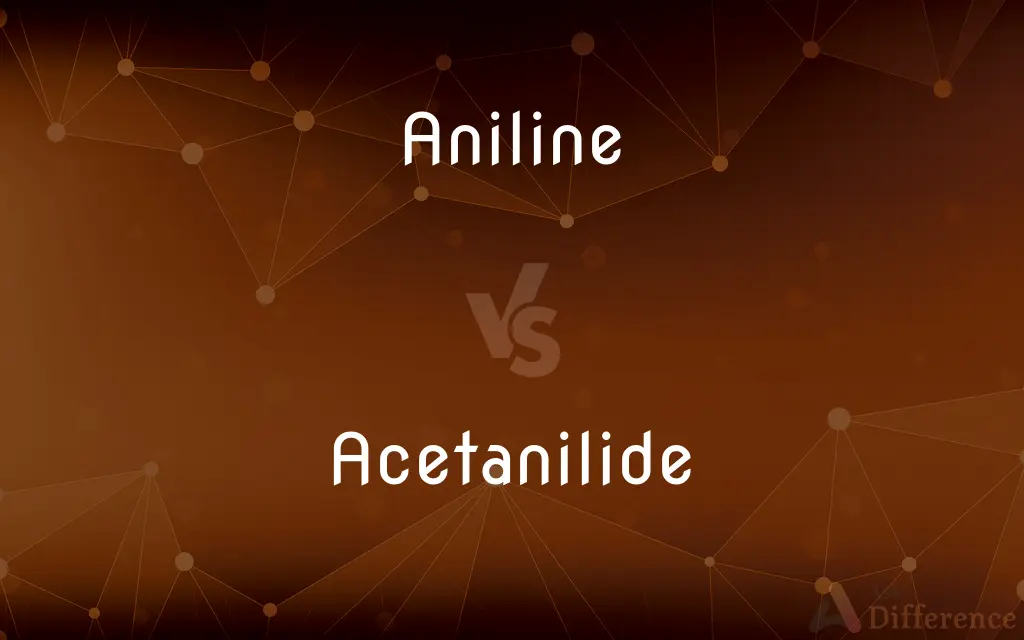Aniline vs. Acetanilide — What's the Difference?
Edited by Tayyaba Rehman — By Fiza Rafique — Updated on April 16, 2024
Aniline is a primary aromatic amine used in dyes and drugs, highly reactive and toxic; acetanilide, derived from aniline, is less reactive and used as a pain reliever and in dye synthesis.

Difference Between Aniline and Acetanilide
Table of Contents
ADVERTISEMENT
Key Differences
Aniline is a simple aromatic amine characterized by its use as a precursor in the synthesis of many important chemicals, such as dyes, drugs, and polymers. On the other hand, acetanilide is a chemical compound that is derived from aniline by acetylation and is used less extensively in similar industries. Both compounds share a benzene ring, but their chemical properties and applications differ significantly due to the presence of different functional groups.
Aniline's high reactivity is attributed to its amino group directly attached to the aromatic ring, which is highly active in chemical reactions. In contrast, acetanilide's amino group is modified by an acetyl group, which reduces its reactivity and increases its stability. This modification changes how each compound interacts with other chemicals and their suitability for different chemical reactions.
The toxicity of aniline is well-documented, with exposure potentially leading to serious health issues such as methemoglobinemia. Whereas, acetanilide, although originally used as a pain reliever, has been found to be less toxic but still poses risks, leading to its restricted use in modern medical applications.
In terms of physical properties, aniline is a slightly viscous, oily liquid that is colorless to slightly yellow at room temperature. Acetanilide, however, appears as a white crystalline solid under similar conditions, reflecting differences in their molecular structure and intermolecular interactions.
Historically, both aniline and acetanilide have been pivotal in the development of the dye and pharmaceutical industries. Aniline was crucial in the discovery of mauveine, the first synthetic dye, while acetanilide was used in the first synthesis of acetaminophen, a widely used pain reliever today.
ADVERTISEMENT
Comparison Chart
Chemical Structure
NH₂ group attached to benzene ring
NHCOCH₃ group attached to benzene ring
Reactivity
Highly reactive
Less reactive due to acetyl group
Toxicity
Highly toxic
Moderately toxic
Physical State
Colorless to yellow oily liquid
White crystalline solid
Common Uses
Synthesis of dyes, drugs, and polymers
Formerly used as pain reliever, in dyes
Compare with Definitions
Aniline
A toxic organic compound used in the manufacture of dyes.
Aniline is essential in creating indigo dye.
Acetanilide
Has a modified amino group.
The acetylation of aniline to form acetanilide alters its properties.
Aniline
A primary aromatic amine.
Aniline's amine group makes it highly reactive.
Acetanilide
A derivative of aniline used historically as a pain reliever.
Acetanilide was one of the first fever reducers in clinical use.
Aniline
Known for its application in the pharmaceutical industry.
Aniline derivatives are common in drug synthesis.
Acetanilide
Appears as a white solid.
Acetanilide is typically seen as a white powder.
Aniline
A colorless oil at room temperature.
Pure aniline remains clear until exposed to air.
Acetanilide
Used in the synthesis of other compounds.
Acetanilide is a starting material in the production of acetaminophen.
Aniline
Used as a precursor in the synthesis of many polymers.
Aniline is polymerized to form polyurethane.
Acetanilide
Less reactive than aniline.
The acetyl group in acetanilide stabilizes the molecule.
Aniline
Aniline is an organic compound with the formula C6H5NH2. Consisting of a phenyl group attached to an amino group, aniline is the simplest aromatic amine.
Acetanilide
Acetanilide is an odourless solid chemical of leaf or flake-like appearance. It is also known as N-phenylacetamide, acetanil, or acetanilid, and was formerly known by the trade name Antifebrin.
Aniline
A colorless, oily, poisonous benzene derivative, C6H7N, used in the manufacture of rubber, dyes, resins, pharmaceuticals, and varnishes.
Acetanilide
The amide derived from acetic acid and aniline; once used medicinally as an analgesic and antipyretic
Aniline
Derived from aniline.
Acetanilide
An amide formed from aniline and an acetyl group (C6H5.NH.CO.CH3); it is a white crystalline compound used as an analgesic and also as an antipyretic. It has molecular weight 135.16.
Aniline
(organic compound) The simplest aromatic amine, C6H5NH2, synthesized by the reduction of nitrobenzene; it is a colourless oily basic poisonous liquid used in the manufacture of dyes and pharmaceuticals.
Acetanilide
A white crystalline compound used as an analgesic and also as an antipyretic
Aniline
An organic base belonging to the phenylamines. It may be regarded as ammonia in which one hydrogen atom has been replaced by the radical phenyl. It is a colorless, oily liquid, originally obtained from indigo by distillation, but now largely manufactured from coal tar or nitrobenzene as a base from which many brilliant dyes are made.
Aniline
Made from, or of the nature of, aniline.
Aniline
Oily poisonous liquid amine obtained from nitrobenzene and used to make dyes and plastics and medicines
Common Curiosities
What were the historical uses of acetanilide?
Historically, acetanilide was used as a pain reliever and fever reducer before safer alternatives were developed.
Why is aniline considered toxic?
Aniline is toxic because it can convert the normal hemoglobin in blood to methemoglobin, which cannot carry oxygen effectively.
Can acetanilide still be used as a medication?
Acetanilide is no longer used as a medication due to its side effects and the availability of safer alternatives.
How does the physical state of aniline differ from acetanilide?
Aniline is a colorless to yellowish oily liquid, whereas acetanilide is a white crystalline solid.
What are the safety measures required when handling aniline?
Proper protective equipment, including gloves and goggles, and adequate ventilation are required when handling aniline due to its toxicity.
What is aniline used for?
Aniline is primarily used in the synthesis of dyes, drugs, and polymers.
What is the significance of the acetyl group in acetanilide?
The acetyl group in acetanilide serves to stabilize the compound and reduce its reactivity, making it safer but less versatile.
How is acetanilide related to aniline?
Acetanilide is chemically derived from aniline by acetylating the amino group.
What role did aniline play in the dye industry?
Aniline was crucial in the discovery and development of synthetic dyes, starting with mauveine.
How does acetanilide affect human health?
Acetanilide can be toxic, causing issues like methemoglobinemia, similar to aniline, though generally it is considered less hazardous.
What are the industrial applications of aniline today?
Today, aniline is extensively used in the manufacture of polyurethane, rubber chemicals, and herbicides.
Why is aniline highly reactive?
Aniline is highly reactive due to its amino group being directly attached to the aromatic ring, making it prone to undergo various chemical reactions.
How has the usage of acetanilide changed over time?
Initially popular as a medication, the usage of acetanilide has shifted primarily to intermediate roles in chemical synthesis and industrial applications.
How does the modification in acetanilide affect its properties?
The acetylation in acetanilide reduces its reactivity and increases its stability compared to aniline.
Is aniline soluble in water?
Aniline is slightly soluble in water but mixes readily with most organic solvents.
Share Your Discovery

Previous Comparison
Shawarma vs. Falafel
Next Comparison
Escape vs. SkipAuthor Spotlight
Written by
Fiza RafiqueFiza Rafique is a skilled content writer at AskDifference.com, where she meticulously refines and enhances written pieces. Drawing from her vast editorial expertise, Fiza ensures clarity, accuracy, and precision in every article. Passionate about language, she continually seeks to elevate the quality of content for readers worldwide.
Edited by
Tayyaba RehmanTayyaba Rehman is a distinguished writer, currently serving as a primary contributor to askdifference.com. As a researcher in semantics and etymology, Tayyaba's passion for the complexity of languages and their distinctions has found a perfect home on the platform. Tayyaba delves into the intricacies of language, distinguishing between commonly confused words and phrases, thereby providing clarity for readers worldwide.











































